 Sunday/Weekend
Sunday/Weekend

Quiet and unassuming, a village not far from downtown Hà Nội takes one back progressively in time, from decades to centuries, making strong historical connections. Bùi Quỳnh Hoa recounts the experience.
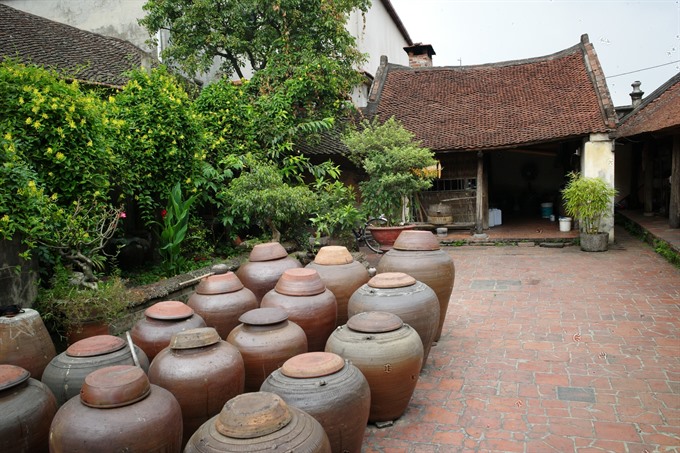 |
| Staple condiment: Jars of soya sauce, a village specialty. VNS Photo Việt Thanh |
by Bùi Quỳnh Hoa
When great writers describe a place, a mere mound on a plain “grows” from an insignificant patch of land into a unique witness to history, and we are able to watch and experience those momentous events unfold. Effectively, we travel back in time.
This is the feeling I get when I step into Đường Lâm Village.
Just an hour away from central Hà Nội, there is place that is a living museum, vibrating in the present even as time seems to have stopped centuries ago.
My heart melts when I step into the village. The sky seems higher, wider and bluer, and the air cooler than the crazy hustle and bustle of the city.
The location helps, I guess. The village stands between the Red River and the Tích River at the outer edge of the northern delta. Its terrain goes up and down rows of hills at the foot of Ba Vì Mountain, and it seems to blend seamlessly into a beautiful landscape of rivers and mountains.
But this quiet, unassuming village and its simple villagers are a deep, even privileged part of the country’s history and culture, and this makes it even more special and profound.
Its increasing fame has meant that a lot of information, about its history and culture are available in brochures and local officials are happy to supply documents to interested visitors.
Thus we know that archaeological evidence including artifacts, old languages, architecture and art from around the foothills of Ba Vì Mountain form evidence of the long history of Đường Lâm, and that the ancient Việt people had lived here from the time of the Sơn Vi Civilisation through succeeding ones - Phùng Nguyên (2000-1500 BC), Đồng Đậu (1500–1000 BC), Gò Mun (1000–600 BC), and Đông Sơn (700 BC–AD 100).
In 1972 Vietnamese archaeologists unearthed many relics at Mound Mả Đống in Đường Lâm Village: axes, tables, wedges, pestles and ceramic decorative objects of all patterns. Bronze drums, jars, ploughshare and axes from Đông Sơn Civilisation have been found aplenty along the Tích and Đáy rivers.
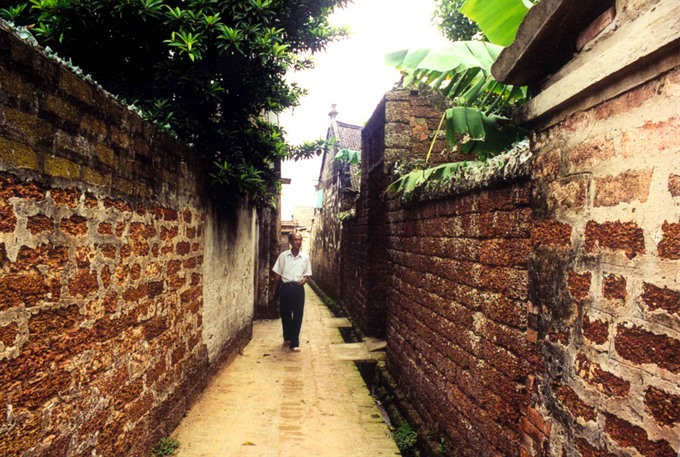 |
| Red bricks: Đường Lâm is part of a region with abundant resources of laterite, and the craft of making laterite bricks is well developed. VNS Photo |
Land of heroes
Đường Lâm is called the Land of Two Kings: Phùng Hưng and Ngô Quyền.
According to historical records, Phùng Hưng (761-802), famous for launching an insurrection against northern foreign invaders to win autonomy for the nation, was born in Đường Lâm. When he died, people showed their deep gratitude to him and praised him as "The Great Father King".
Ngô Quyền (896-944), descendant of a notable tribe in Đường Lâm, defeated the Southern Han troops at the Bạch Đằng River in 938 and proclaimed himself the king, setting up his capital in Cổ Loa. Historians treat this point in time as the point of liberation from Chinese domination.
Cultural czars
Đường Lâm is also the birthplace of many other prominent cultural and historical personalities.
Confucian scholar Giang Văn Minh (1573–1638) became a diplomat martyr after he was sent as an envoy to the Chinese Ming court during the reign of King Lê Thần Tông in 1637. For asserting the nation’s independence, he was killed.
Another Confucian scholar and educator, Kiều Oánh Mậu (1854-1912), a district governor, an educational inspector and teacher of the famous Đông Kinh Nghĩa Thục School, was also a native of Đường Lâm.
Places of worship
With a history of such eminence, it follows that the village has plenty of ancestors to worship: the Mía Pagoda, Lady Mía Temple, the Phùng Hưng Communal House, the Ngô Quyền Temple and Tomb, the Phủ Temple, the Giang Văn Minh Temple, and the Mông Phụ Communal House.
In feudal times, communal houses were classified according to territorial administration: the communal house of the commune, of the village, and of the hamlet. Around Đường Lâm, all these types of communal houses are preserved.
The communal house for the commune stands in Đông Sàng Village; those for the village are in Đông Sàng, Mông Phụ, Cam Thịnh, Đoài Giáp, Yên Thịnh and Cam Lâm villages; and communal house of hamlet is located in Phụ Khang.
One of these stands out in particular.
“The 2,000sq.m Mông Phụ Communal House is a prominent spot in Đường Lâm’s landscape,” said Giang Vĩnh Phúc, the communal house keeper.
“It is located where there are no rivulets, ponds or rivers. So the villagers dug two wells as substitutes. They are believed to be the eyes of a dragon. The water from one well is clear while water from the other is slightly turbid,” said Phúc, 74, a 14th generation descendant of Confucian scholar Giang Văn Minh.
Phúc said the Mông Phụ Communal House was built in 1759. It originally consisted of three main compartments and two small annex compartments. Compared with other communal houses in this region, it was very small. Therefore, 100 years later in 1859, under King Tự Đức’s reign, the villagers added a new building linked to the old communal house by a tube-shape structure. The original small communal house was turned into the Rear Sanctuary, thus becoming one of the largest rear sanctuaries in this region.
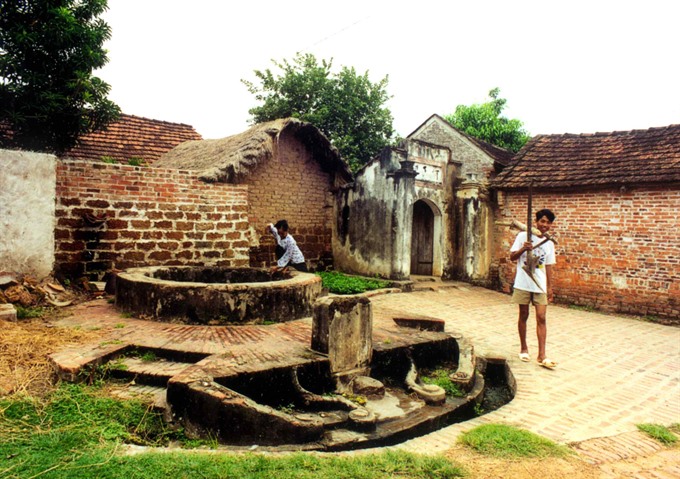 |
| Then and now: An ancient water well in Đường Lâm Village. VNS Photo |
The Mông Phụ Communal House is dedicated to the cult of the tutelary Tản Viên (or Ba Vì Mountain God), but its festival also honours national hero Phùng Hưng.
In front of Mông Phụ Communal House stands the Council Hall, an example of architecture from the French colonial period, which has been kept relatively intact, adding beauty to the local landscape.
“There is a special structure located in isolation on the right side of the communal house’s main gate,” Phúc said.
“Called Xích Hậu House, it is a small but refined building composed of three main compartments and two small auxiliary compartments. In the old times, young village girls would come to this house to conduct a ceremony on their wedding day. You cannot see this in other communal houses,” he claimed.
Over the successive dynasties, the Mông Phụ Communal House was granted 17 royal certificates of honour.
Laterite everywhere
The most striking aspect of Đường Lâm for me are the brick houses with their amazing earthen red and orange colours that seem to add coolness to the whole place.
In a region with laterite sources, the craft of making laterite bricks for buildings developed very early.
Almost every building and every other structure in the place is built with laterite bricks – ancient houses, garden fences, water wells.
Hundreds of houses here have survived for hundreds of years, giving this village an ambience few others in the country can match.
“An ancient house used to have three or four rows of columns (36 columns in total),” said Nguyễn Văn Hùng, owner of a house built in 1649.
“The architectural components of our ancient houses like the gate, surrounding wall, yard, main house and kitchen are worth studying. The main house and the auxiliary house are often arranged in an “L” shape.
“The architectural features here show that they were developed by an agricultural population not much affected by urbanisation. There are hardly any houses with doors opening towards the road. The gate of a house cannot be placed opposite the central compartment of the house.”
And the tradition of planting perennial trees and vegetation in the garden makes a house more beautiful, creates a peaceful scene and limits unfavourable climatic effects,” Hùng said.
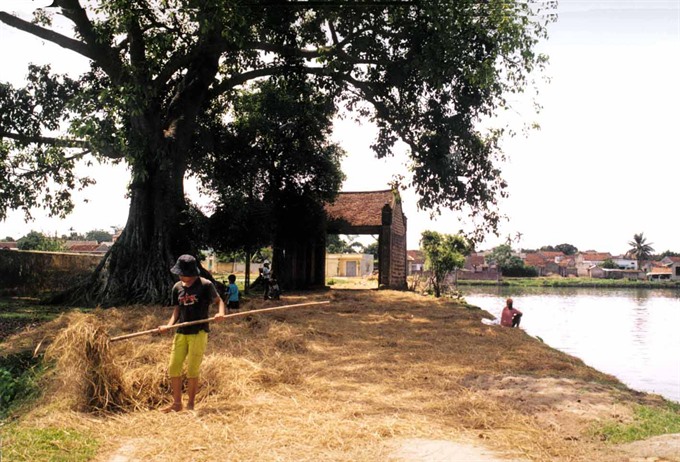 |
| Rural features: There were many gates leading to the Đường Lâm Village in the past, however Mông Phụ Gate is the main one that stands today. VNS Photo Đoàn Tùng |
Tourism and restoration
Taking note of the significant history and culture of the Đường Lâm ancient village, the Hà Nội administration has initiated a 2014-2020 project to restore ancient houses in the village.
“Until now, the city has invested in repairing 15 ancient houses (with a total maximum investment of VNĐ800 million, about US$35,500, for each house), 10 ancient wells and four relics in the village. The restoration work has aimed to keep original values.
“Investment has also been made in local infrastructure like a school, a market, a clinic, an inter-village road and radio broadcasting station,” said Nguyễn Trọng An, deputy head of the Đường Lâm Relic Management Board.
Đặng Văn Bài, former chairman of the Cultural Heritage Unit under the Ministry of Culture and Information, said, “We consider the preservation of Đường Lâm as our responsibility to future generations.”
The village has received Japanese help in retaining its originality.
Kariya Yuga, councilor of Cultural Properties Department, Japan Agency for Cultural Affairs, said: “I sincerely hope that Đường Lâm Village, a spiritual home and representative traditional village of the Vietnamese people, will be inherited by future generations, and the conservation efforts will serve as a model for other countries.
“As a nation with the same cultural background of wooden architecture and agriculture, we are honoured to be able to participate in this co-operation project," Yuga said.
I have to say that Đường Lâm has retained the basic characteristics of Vietnamese ancient village so well that every corner is a postcard picture - the banyan tree, the village gate, the wells and the communal houses court.
It is not surprising that it is receiving more domestic and international visitors every year. It has also become a favourite place for couples to take wedding pictures, create artwork or shoot videos.
For me, Đường Lâm is more than all of this. Even while it is the place that carries the history of the nation’s struggles and achievements, and acts a repository of cultural traditions, it showcases a simplicity that is in itself a sanctuary whose tranquility I can carry in my heart even after I have returned to my “other” life. VNS
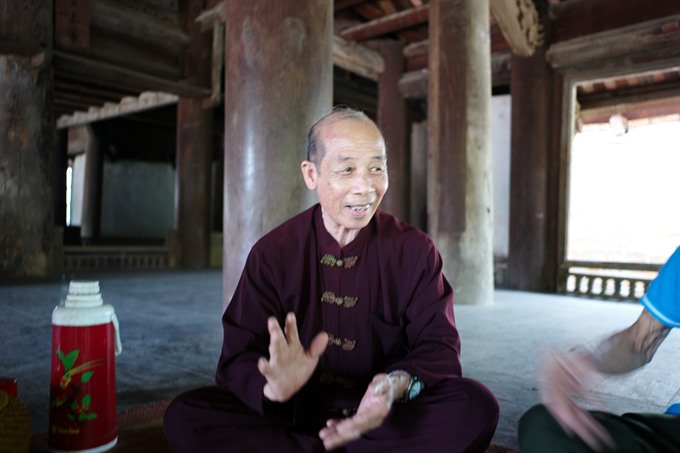 |
| Illustrious ancestry: Giang Vĩnh Phúc, the Mông Phụ Communal House keeper, a 14th generation descendant of Confucian scholar Giang Văn Minh. VNS Photo Việt Thanh |
77540907PM.jpg) |
| Growing attraction: More and more foreign visitors have been visiting Đường Lâm over the last few years. VNS Photo Việt Thanh |
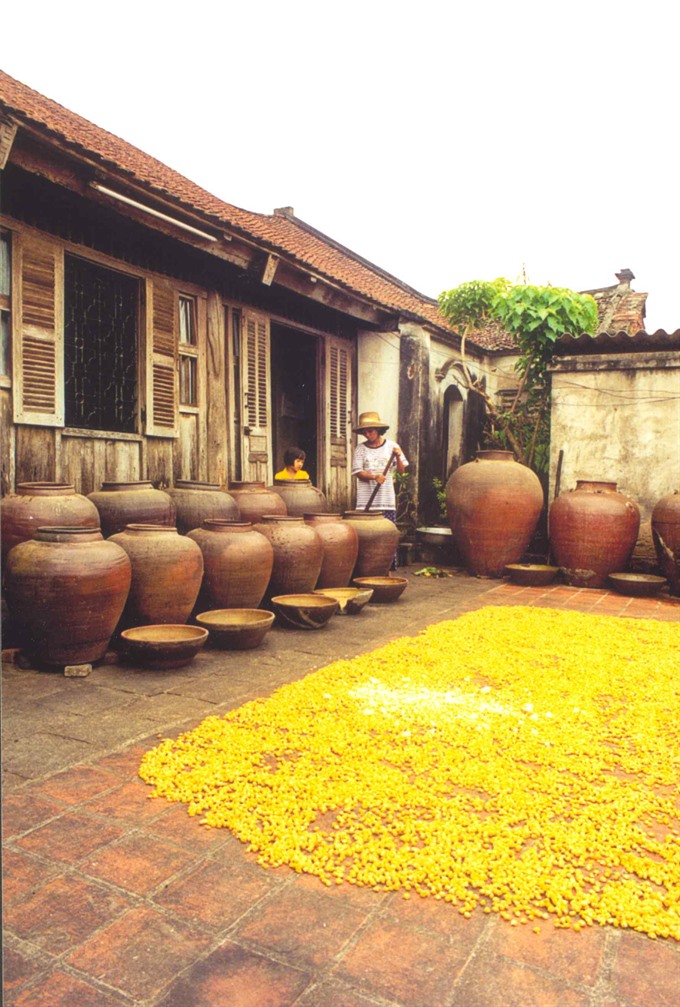 |
| Homemade: Many families in the village earn their living by making soya sauce. The beans are spread on the brick-paved yard. VNS Photo |
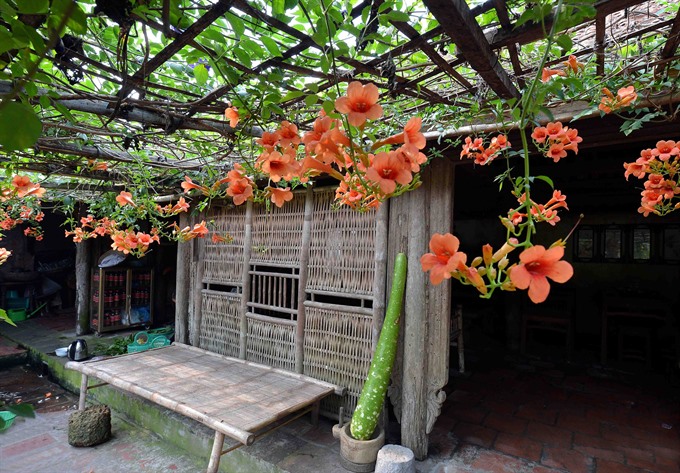 |
| Unchanging vista: Nguyễn Văn Huyến’s ancient house is a main attraction in Đường Lâm Village. VNA/VNS Photo Thanh Hà |




